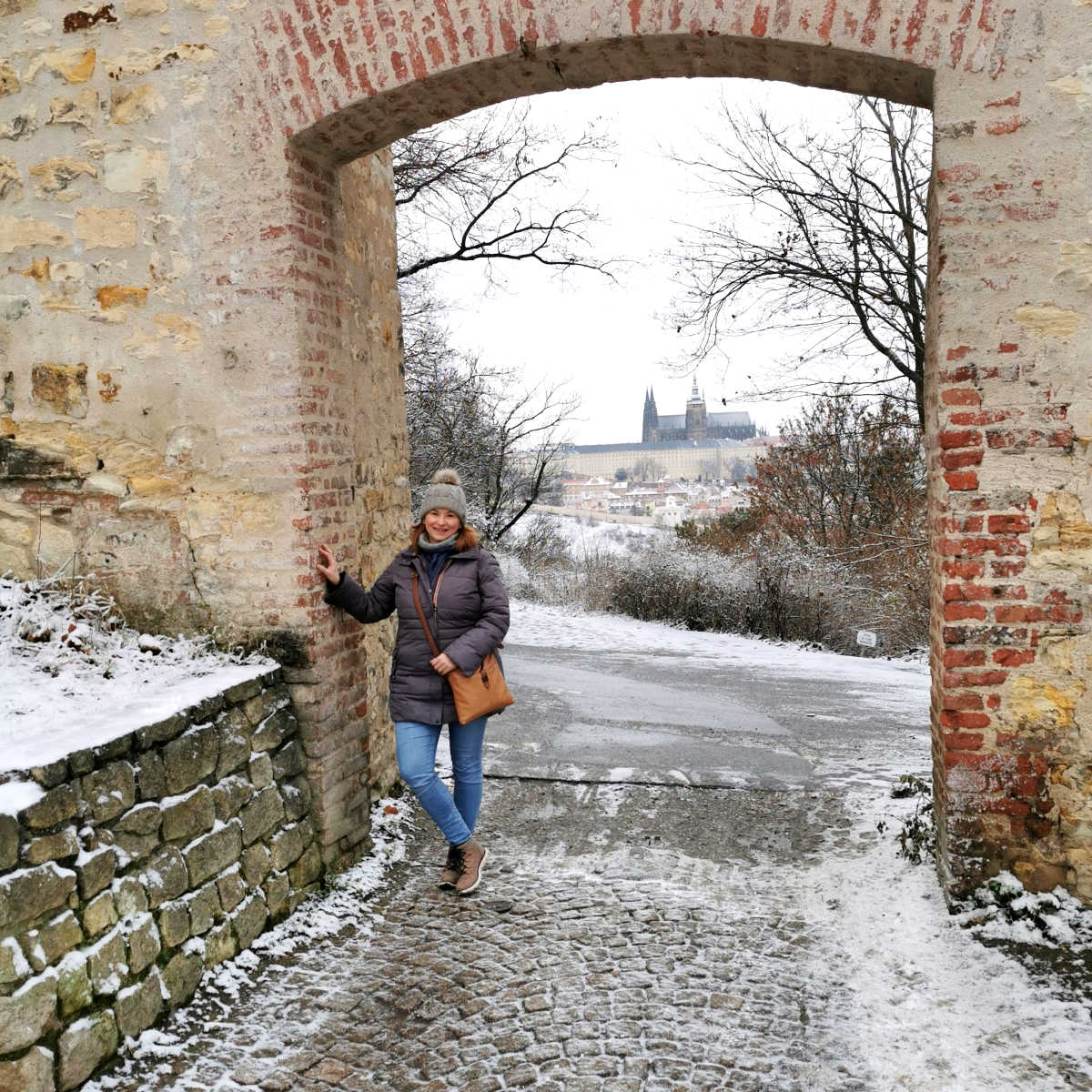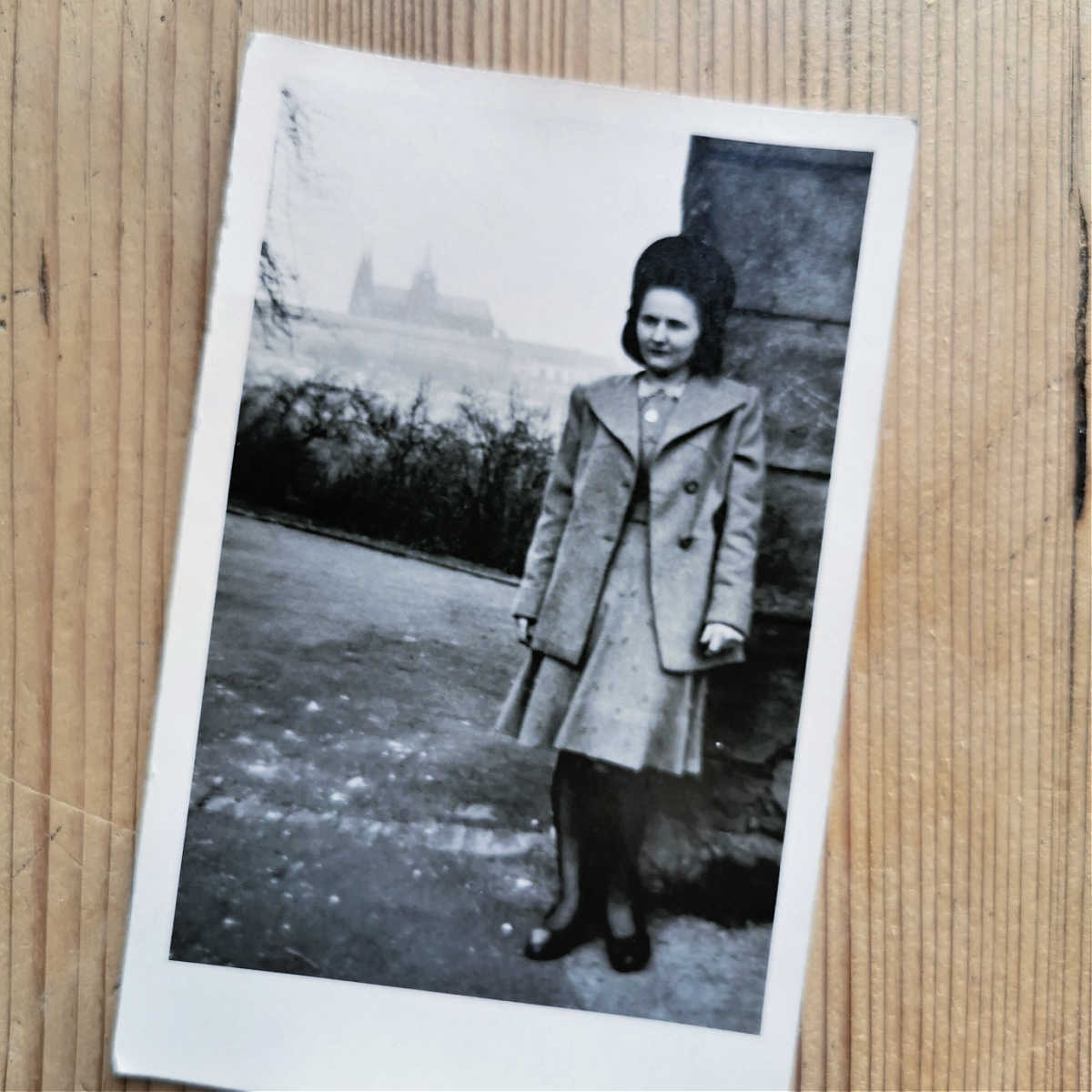Hunger Wall (Hladova Zed) is part of my favourite walk from Smichov to Kinsky Garden Park, Nebozizek Gardens, Petrin Hill and then all the way to the Strahov monastery and the Hradcany.
Every time I walk my favourite way to walk to Prague Castle I wonder how much (or little) it changed since my grandmother walked the same walk many years ago. I once found a lovely photo of her (taken by my grandfather) where she stands next to the gap in the Hunger wall with a view of Prague Castle behind her.

I tried my best to recreate the same photo and the only difference is me and the fact that the photo is in colour. Other than that nothing much has changed!
History of Hunger Wall on Petrin Hill
Hunger Wall was originally built as a defensive wall to keep Prague safe. As you can imagine Prague in medieval times was much smaller than it’s now and beyond the Hunger Wall were just fields and a few scattered villages and farmsteads.
The wall is visible from far away, better in the winter when there are no leaves on the trees, but even in the summer, you can trace the wall from as far as the lookout on the Powder Tower viewing walkways.
The Hunger Wall was built between 1360-1362 on a direct order by Charles IV (the famous Bohemian – Czech king who also owned Karlstejn).
The wall was originally much higher and wider than it is in places now. The wall it’s said to be between 4 to 4,5 metres high and up to 2 metres wide in places.
There would have also been battlements and bastions along the wall for the watchmen and soldiers to shelter and help defend the town.

Hunger wall repairs and new access through the wall
The Hunger Wall was repaired many times over the years, back in the 1624, middle of 18th century and later in 1930s and again in 1975.
When the Kinsky Garden was opened to the public (until the beginning of 1900 the garden was privately owned by the Kinsky family), the opening was cut into the wall, so that you can now walk directly from the garden to Neboziek and Petrin Lookout Tower on the top of the hill.. Beforehand, there was no access through the wall.
Most of the bastions didn’t survive, but you can still see one of them being used as base for the Stefanik Observatory, which is on the top of the Petrin Hill right next to the terminal for the Petrin funicular.
Whilst it looks like the Hunger Wall was built to carve up Petrin Hill, the original length was much longer. The wall used to run down the Petrin Hill to Ujezd and to Vltava River and you can still see a well preserved part of the wall in the courtyard of house Plaska Street no. 8, which is now a hotel.
The myths surrounding the Hunger Wall
There are so many interesting facts about Prague, but this one has to be one of my favourite ones. There is a lovely story that surrounds the Hunger Wall, which might or might not be true. It’s said that the wall wasn’t build because of any defensive reasons, but because the king wanted to give people meaningful jobs for which he could pay them.
At the time (1361) there was a famine in the Prague and king Charles IV wanted to give people work, so he pretty much invented the idea of the wall.

The story behind the reason why the wall is called ‘hungry’
Because it was built by the local poor (and hungry) people the wall is also nicknamed as Zubata Zed (Wall with teeth). You can see it still has a jagged top of the wall. But the name apparently doesn’t come from how the wall looks, but because when King Charles IV ordered to build this wall, he wanted the teeth of poor people to have something to bite into – as in he paid them with food. The wall was also known as Chlebova Zed (Bread Wall) – as in wall that was built in exchange for food – bread.
Further myths were established about 100 years after the wall was built, when the local records writer Vaclav Hajek from Libocan (and possibly Bohuslav Balbin) added to the story, that king Charles IV helped to build the wall by working alongside the regular workers to help his people.

How the story of the wall changed by the 19th century
By the time the story reaches Alois Jirasek (19th Century), it goes something like this: There was a famine in Prague and one day after Charles IV was just about to leave a church, he was stopped by a group of 2000 hungry people who were begging him to give them any kind of work and saying that they would be happy to work for free – only for food.
The king asked them to come back the next day and when they did, he took them to the top of Petrin Hill and asked them to start quarrying the stone from the top of the hill and to build a wall that would stretch from Vltava river to Petrin Hill and then to Strahov Monastery.
Once people started to work on the wall, others joined them too as they heard that there is enough food, shoes and clothes for everyone who works on this wall. The king checked on the progress often and people blessed him for his kindness.
How to get to Hunger Wall in Prague
You can start exploring the wall from the bottom of the Petrin Hill at Ujezd (Trams 22, 9,12, 15) or walk through the Kinsky Garden. You can also start your walk on the top of the hill by taking the cable car (Lanovka) at the bottom of Ujezd.
STAY IN TOUCH
Hope this blog post inspires you and as ever I’d love to what you think! Let me know in the comments below or catch up with me over on Instagram.
Magdalena
This blog post was originally written on 23 April 2022 and last updated on 3 June 2024
PIN TO KEEP FOR LATER

